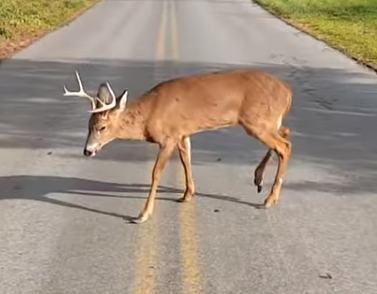Zombie deer are sweeping the nation! No, they’re not. Well, not like you have been led to believe.
By now you’ve seen videos of so-called zombie deer. The videos are nearly always the same: person observes a deer walking in circles, stumbling about, and showing little to no fear of humans. And, you have probably already also read or heard numerous online “experts” provide their prognosis as chronic wasting disease. Don’t believe it.
We have been following deer diseases since 1973 and rely on scientific facts and true expert analysis from trained biologists.
Simply put, we have seen few verified videos of deer with manifested chronic wasting disease over the past 25 years. What’s circling about on social media these days are videos (and photos) of deer with other diseases:
Hemorrhagic Disease (EHD and BTV) in Deer
According to researchers at Purdue University, epizootic hemorrhagic disease (EHD) and bluetongue virus (BTV) are viral diseases, collectively called hemorrhagic diseases (HD), and are common in white-tailed deer. Both diseases are transmitted by biting midges often called “no-see-ums” or gnats. Neither disease is a human health issue, but they can cause significant mortality in white-tailed deer. Outbreaks of HD tend to impact deer populations locally, meaning an outbreak may occur in one part of a county but not in other parts.
Deer with clinical EHD and/or BTV are often disoriented, walk in circles and show no fear of humans. In both cases, the deer appears otherwise healthy, not emaciated, as the diseases progress rapidly before death.
Cranial Abscessation Syndrome (CAS) in Deer
Adult antlered deer from all over Wisconsin have been diagnosed with cranial abscessation syndrome (CAS). As reported by the Wisconsin DNR, deer with CAS may appear blind, and uncoordinated and may show abnormal behavior such as aggression toward people and stationary objects, or not moving when approached by people or dogs. Signs of CAS include swollen eyes, broken antlers weeping fluid, swollen joints, foot sores and lameness. Pus may be observed at the base of the antlers or in eye sockets.
CAS is more commonly reported in bucks than does, likely because the bacteria enter wounds that result from sparring between bucks.
Chronic Wasting Disease (CWD)
While it is true that deer with CWD can exhibit bizarre behavior — walking in circles and clumsiness — very few have been documented. The reason being is that deer with clinical CWD will be emaciated to the point of near death. These cases are easily identified. The deer have withered away to practically nothing and are on the throes of death. The reason why we see few cases is because these deer typically are found within security cover and away from human populations. Also, by the time a deer hits the clinical stage, it is highly susceptible to predation (wolves, black bears, coyotes, bobcats, etc.).
If you run across a deer behaving oddly, report it to your local wildlife officer or game department.

